
Unleashing Your Crafting Potential: Mastering the Fundamentals of Foam Cutting
Making your own foam creations can feel like stepping into a realm of creativity, but the process often requires specialized tools and equipment. Today, we’re diving deep into the world of DIY hot wire foam cutters and exploring how to power them. We’ve got all the information you need to master this essential craft skill!
The allure of working with foam is undeniable. Its versatility allows for a myriad of projects – from intricate art pieces to practical home decor. But, like any creative endeavor, crafting with foam requires precise control and specialized equipment.
Enter the hot wire foam cutter: your secret weapon in achieving flawless cuts. This tool utilizes an electric current that passes through a specially designed wire to melt away the foam’s surface layer, leaving behind a clean cut.
Hot wire cutters offer exceptional precision, allowing for intricate detail work and smooth curves. But, like any powerful tool, it demands responsible use, precise understanding of its operation, and proper power management.
So, how do you get started? Let’s break down the essential components of a DIY hot wire foam cutter power supply.
Powering Your Foam Cutting Expedition: A Deep Dive into DIY Power Supplies
The heart of your hot wire foam cutter is its power supply – the lifeblood that fuels your cutting magic. This device converts your household electricity into the precise voltage necessary to operate the hot wire. It’s a small but mighty component, and understanding its function is critical for safety and efficient operation.
A DIY power supply can be surprisingly straightforward to design and assemble. The core concept revolves around using readily available components like resistors, capacitors, and an appropriate voltage regulator.
For beginners, utilizing a simple transformer circuit provides an excellent starting point. A transformer steps down the voltage from your household outlet, ensuring it’s within the safe operating range of your hot wire.
Next comes the resistor section – this component is crucial for controlling the current flow and temperature of the hot wire. It ensures that the heat generated by the electric circuit remains at a manageable level.
Crafting Your Own Power Supply: A Step-by-Step Guide
Creating a DIY power supply requires careful planning and execution, but don’t fret! We break down the process into simple steps to make it a breeze for you.
- **Safety First:** Before even touching any wires, remember, electrical current is dangerous; always wear safety gear like insulated gloves and goggles throughout the entire process.
- **Choose Your Components Wisely:** Select a transformer with the proper voltage and amperage for your hot wire cutter. Experimentation and testing are key to ensuring your power supply delivers consistent results.
Once you have your components, understand their significance and purpose:
- **Resistor (R):** This component controls the current flow through the hot wire. The right resistor will prevent excessive heat build-up but also allow for proper voltage regulation.
- **Capacitor (C):** The capacitor acts as a smoothing device, dampening any sudden fluctuations in electrical current to ensure stable operation of your cut.
- **Voltage Regulator (VR):** This component ensures the output voltage matches the requirements of your hot wire, allowing it to function safely and efficiently.
Building Your Power Supply: Step-by-Step Instructions
The world of DIY power supplies is vast, but here’s a simplified guide to get you started.
**Step 1:** Secure your transformer in a suitable enclosure.
**Step 2:** Connect the resistor, capacitor, and voltage regulator in series with the primary winding of the transformer. The resistors should be placed before the capacitors, while the capacitors are connected in parallel to each other. The outputs from these components should connect to the secondary winding.
**Step 3: Testing Your Supply:** Plug your power supply into a device like an LED light or a voltmeter. If it seems strong and stable, you might have created a working power source for your hot wire foam cutter.
Troubleshooting & Safety: Preventing Mishaps
Even with the most meticulous setup, unforeseen challenges can arise. Let’s explore some common troubles and how to address them:
**Troubleshooting:**
- **Overheating:** If your hot wire begins to overheat too quickly, your power supply may be delivering an incorrect voltage or the resistor may not have sufficient resistance to control current flow. Try re-adjusting these components and test the circuit again;
**Safety First!**: Always remember that working with electricity involves inherent risks. When in doubt, consult a professional electrician for guidance.
Embracing the Art of Foam Cutting
Now that you’ve mastered the foundations of DIY hot wire foam cutting power supplies, it’s time to unleash your inner artist! Experiment with different techniques and materials to create unique and imaginative pieces.
Remember:
- **Start Simple:** Begin with basic shapes like squares, circles, and triangles before tackling intricate designs.
- **Practice Makes Perfect:** The more you practice, the better your control over the hot wire becomes.
With time and dedication, you’ll be crafting stunning foam creations with ease. We encourage you to embrace this art form and explore its boundless potential!



